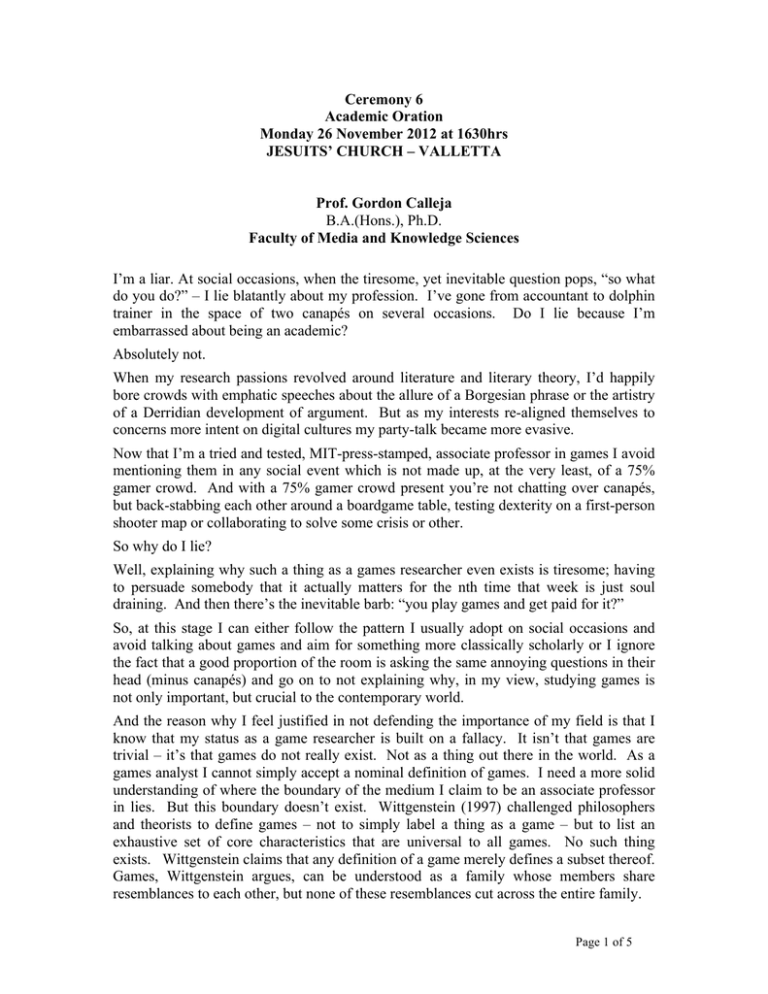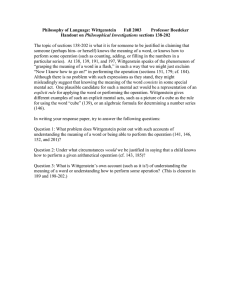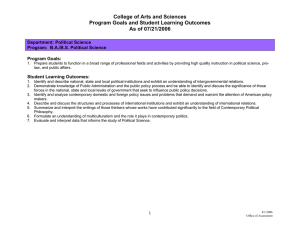Ceremony 6 Academic Oration Monday 26 November 2012 at 1630hrs
advertisement

Ceremony 6 Academic Oration Monday 26 November 2012 at 1630hrs JESUITS’ CHURCH – VALLETTA Prof. Gordon Calleja B.A.(Hons.), Ph.D. Faculty of Media and Knowledge Sciences I’m a liar. At social occasions, when the tiresome, yet inevitable question pops, “so what do you do?” – I lie blatantly about my profession. I’ve gone from accountant to dolphin trainer in the space of two canapés on several occasions. Do I lie because I’m embarrassed about being an academic? Absolutely not. When my research passions revolved around literature and literary theory, I’d happily bore crowds with emphatic speeches about the allure of a Borgesian phrase or the artistry of a Derridian development of argument. But as my interests re-aligned themselves to concerns more intent on digital cultures my party-talk became more evasive. Now that I’m a tried and tested, MIT-press-stamped, associate professor in games I avoid mentioning them in any social event which is not made up, at the very least, of a 75% gamer crowd. And with a 75% gamer crowd present you’re not chatting over canapés, but back-stabbing each other around a boardgame table, testing dexterity on a first-person shooter map or collaborating to solve some crisis or other. So why do I lie? Well, explaining why such a thing as a games researcher even exists is tiresome; having to persuade somebody that it actually matters for the nth time that week is just soul draining. And then there’s the inevitable barb: “you play games and get paid for it?” So, at this stage I can either follow the pattern I usually adopt on social occasions and avoid talking about games and aim for something more classically scholarly or I ignore the fact that a good proportion of the room is asking the same annoying questions in their head (minus canapés) and go on to not explaining why, in my view, studying games is not only important, but crucial to the contemporary world. And the reason why I feel justified in not defending the importance of my field is that I know that my status as a game researcher is built on a fallacy. It isn’t that games are trivial – it’s that games do not really exist. Not as a thing out there in the world. As a games analyst I cannot simply accept a nominal definition of games. I need a more solid understanding of where the boundary of the medium I claim to be an associate professor in lies. But this boundary doesn’t exist. Wittgenstein (1997) challenged philosophers and theorists to define games – not to simply label a thing as a game – but to list an exhaustive set of core characteristics that are universal to all games. No such thing exists. Wittgenstein claims that any definition of a game merely defines a subset thereof. Games, Wittgenstein argues, can be understood as a family whose members share resemblances to each other, but none of these resemblances cut across the entire family. Page 1 of 5 The things we call games are a lens that we adopt in the midst of an activity in which we are engaged. Sometimes that activity is facilitated through physical objects: marks on a space or virtual spaces brought to life on a screen in photo-realistic glory. At other times, no such things exist and the game is merely a system in a player’s or number of players’ minds. It is not uncommon for two players engaged in the very same game object to be playing different games. This is because digital games are better understood as hybrids of two families: games and virtual environments. The result is virtual environments that have ludic elements designed into them. These ludic elements are not set characteristics, but perspectives that change through time and communities of practice. The important thing to keep in mind is that a lot more than gaming occurs in game environments. And I say gaming, not playing here, in a pointed manner: in English we use the term “playing” to refer to an engagement with a game. In Dutch, Italian, French, Norwegian, Danish and several other languages the same word is used for both the noun and the verb. In Norwegian, for instance: vi spiller et spil – we game a game. The reason I bring this up is that another common misunderstanding is that engagement with games is somewhat playful: that they have some sort of experiential quality that marks them from other activities, a quality irreducibly undercut, supposedly, by its opposition to that something else we call ‘work’. Engagement with games, however, is not always playful, inasmuch as they are not always ‘fun’ either. Several participants I interviewed when investigating player involvement in games explained how their activities in the game in question, World of Warcraft (Blizzard Entertainment, 2004), were similar to their work lives. Hence, for instance: clerks who rushed home to log on to perform an inventory of materials currently held by the guild’s stores (a guild is a society players belong to in Massively Multiplayer Games), in preparation for a lengthy and complex quest they would embark on that evening, or bank managers who spend their free time delegating tasks to guild members under their authority, in order to attain materials that would craft the items needed for the same quest… and so on. My point (and I would like to re-emphasise this) is that the things we call digital games are not really games. They are not so from an ontological (theoretical) perspective, nor are they so from an empirical (sociological/anthropological) one. These artefacts are better understood as cybernetic systems that are often hybrids of other media objects, including any combination of narrative media such as literary texts or film; physical games such as sports, board games, card games and puzzles; virtual environments such as architectural 3D models or social worlds; networked communities such as message boards or social media platforms and others. But what is at the heart of an academic inquiry into such a medium? Well, since digital games are simulations of pretty much any human activity, factual or fictional, game studies draws people from across the humanities, social sciences, computer sciences and design disciplines. The fields that make up this discipline each bring a different perspective and have a different burning question (or set of questions) at the heart of their varied inquiries. My own burning question – the passion that fuels my own interest in game research – is one that is, I think, at the heart of critical analysis of all media forms within the Page 2 of 5 humanities: how do digital games reflect our contemporary existence? In other words, what do games tell us about the human condition? And here’s one path into the thorny maze this question presents: Every man-made object and system expresses a facet of humanity’s drive to control our surroundings; to transform the environment we find ourselves in into one subservient to our needs, comforts and fears. These systems, be they upheld by code or convention, be they local or multi-national, are the webs that hold human society together. We weave systems upon systems to establish an order in a world that is otherwise beyond our control. Similarly we make games that reflect the outside world in a more bearable manner. The Sims (Maxis Software, 2000), for example, is a dollhouse brought to life. Like the dollhouse, The Sims portrays an ordered world of ideal objects, which we can afford to possess through simulation and miniaturization. The Sims is considered to be a great example of open-ended game-play. You’re provided with an open world without discrete goals or pre-set narrative. But this freedom of action hides the fact that the possibilities for exerting agency are constrained by the designers’ codified world-view written into the game’s rules and code. Just as Jean Baudrillard claimed that Disneyland exists to distract us from the simulacral nature of its surrounding culture, so The Sims exists to distract us from the fact that the everyday reality it simulates is, so to speak, equally game-like. The only difference is there is no safe-word in this virtual reality. Unlike Allegra Geller’s situation in the movie Existenz (Cronenberg, 1999) there is no symbol on the palm to press to exit this game. That is the artistry of games: to present themselves as games standing in stark opposition to the real, the serious, the earnest. Play theorists from Johan Huizinga (1955) to Roger Caillois (1962) all the way through to contemporary game researchers have defined games as ordered and bounded spaces standing aside from ordinary life. What none of these theorists explain is what actually lies out of that boundary – often referred to as the “magic circle” (Salen & Zimmerman, 2003). The answer is that there is no magic circle. There is no outside and inside of games. More significantly, there is no entrance or exit to the game that is contemporary social life. At every level of socially-structured existence, from the flimsy virtuality of our economic systems, to the laws of traffic, to educational systems right down to the most intimate friendship and flirtation, humanity has woven itself an intricate web of games spun into games without reprise or exit. To a cynical game theorist, the pixellated images on game-screens are not the shadows on Plato’s cave: they are the forms that remind us that it’s shadows all the way through. When the player crawls out of their game cave, they don’t find a world of light and solid forms, they find another cave of bleary-eyed figures hunched over keyboards, all unsure what they’re playing at in this game we call life. Only the rules of that game are not, so to speak, as well designed, or as accountable. Games are simulations, but they are not simulations of any stable, physical reality out there. They are simulations of the knot of arbitrary systems that determine the major part of our waking life. The main difference is that the guiding principles of game design aim for more level playing fields – for more legible and easily internalizable systems that offer interesting choices. Game systems are, to some players, more attractive than their non-ludic counterparts because of the iterative improvement in design wisdom accumulated through the last few Page 3 of 5 decades of game design. Games offer a meticulously ordered world with rewards that are often varying in their value, but guaranteed. They offer the chance to learn by failure. The cybernetic feedback loop that underlies every game-system educates those that engage with it in its expectations, which are, in part, the expectations of its designers. And I say ‘in part’ here, because often game spaces afford means to subvert the expectations of their creators, either through designed or unintended emergent properties. Of course, there is an attraction to the specific setting the game world presents, but do not be fooled by the wrapping: the skin might be made of orcs and droids but the structure that lies underneath is very much a revision of the structures that underlie more mundane wrappers. If the wrapper attracts the eye with its shine, it is the underlying structures, along with the bonds and tensions with other networked minds, that keeps gamers engaged. And it is here, at the heart of their structure, that we need to start our inquiry. Countless studies that deal with violence, addiction and other supposed evils of the medium start and end with the wrapping. A blood splatter here and an AK-47 there are not novel entrants to our media-saturated collective unconscious. If half the gaming population were half as influenced as these researchers, with all their misplaced solicitude, claim they are, then as players and thus affected by games we wouldn’t be sitting in this room, proud, solemn or eating our own heads in boredom at these windy words. Rather, we’d be locked up with our loved ones behind shuttered doors and windows, clutching a blunt instrument at the ready. This is not to say the things we call games are or are not, to some extent, sinister; it’s to emphasize that any sinister elements they might harbour is a designed replication of those elements in the societies and cultures that designed them. But more importantly, by thinking of games as something apart, as something nonserious or trivial, we miss their cultural significance; we miss the real reasons for their rapid ascent into media pole-position. What we should be concerned about is not their virtuality, their playfulness, their opposition to the serious and the real. What we should be concerned about is how similar everyday life is to games, and yet, for many of us, how lacking it is in comparison. The core concern of game research is not to crown them as the royal medium du jour, or to claim, as some of the more starry-eyed, TED-talking, game researchers have, that games can save the world — but rather to understand the specific qualities of this complex medium and in so doing offer a reflection on the society and culture that created them. Game research offers more than a decoding of a new cultural form – it offers the decoding of an entire cultural history through the lens of this contemporary artefact. In so doing, I believe that they also configure a new aesthetics – but that would be the topic for another occasion. Thank you for listening to these thoughts on the ludic aspects on our lives. I would like, at the end, to take the opportunity to congratulate all graduands today, and to wish them all well in their life, both at work and at play. Page 4 of 5 References Baudrillard, J. (1983). Simulations. New York: Semiotext(e). Blizzard Entertainment. 2004. World of Warcraft. PC: Vivendi Universal. Caillois, R. (1962). Man, play and games. London: Thames and Hudson. Cronenberg, D. (1999). Existenz [videorecording]. Montreal, Quebec: Alliance Atlantis,. Huizinga, J. (1955). Homo ludens; a study of the play-element in culture (1st Beacon paperback ed.). Boston: Beacon Press. Maxis Software. (2000). The Sims. PC: Electronic Arts. Salen, K., & Zimmerman, E. (2003). Rules of play : game design fundamentals. Cambridge, Mass.: MIT Press. Wittgenstein, Ludwig, and Anscombe, G. 1997. Philosophical Investigations. 2. ed. Cambridge, Mass: Blackwell. Page 5 of 5



